Home
Introduction
In English
In Greek
The Founding of EKA and its history
to the end of the 19th Century
In English
In Greek
EKA in the 20th century
In English
In Greek
EKA today
In English
In Greek
Past Presidents and Committee members of EKA
In English
In Greek
The Alexander the Great Centre of Post-Graduate Studies and Research
The protagonist and main financial backer of this triptych vision was MICHAIL TOSITSAS first president of EKA and Consul General of Greece in Alexandria, who is considered to have been the father of Egyptian Hellenism.
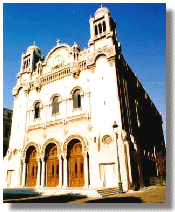 In 1847 Tositsas donated a plot of land for the building of the first Community church - the Church of Evangelismou tis Theotokou (the Church of the Annunciation of the Virgin) - which opened in 1856 and still operates today. It was here that His Beatitude Petros VII, Pope and Patriarch of Alexandria and All Africa was enthroned in March 1997.
In 1847 Tositsas donated a plot of land for the building of the first Community church - the Church of Evangelismou tis Theotokou (the Church of the Annunciation of the Virgin) - which opened in 1856 and still operates today. It was here that His Beatitude Petros VII, Pope and Patriarch of Alexandria and All Africa was enthroned in March 1997.
When diplomatic relations between Greece and Turkey were broken off in 1854 due to the Greek stance towards the Russian-Turkish War, Tositsas and many other Greeks were obliged to leave the country.
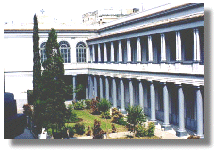 1854-1857 Michail Tositsas financed the first Greek Community School, which was opened bearing his name, in 1854, under the presidency of his successor Stefanos Tzitzinias. The school operated for 114 years before closing in 1968. The building now houses the Greek Orthodox Patriarchate of Alexandria and All Africa.
1854-1857 Michail Tositsas financed the first Greek Community School, which was opened bearing his name, in 1854, under the presidency of his successor Stefanos Tzitzinias. The school operated for 114 years before closing in 1968. The building now houses the Greek Orthodox Patriarchate of Alexandria and All Africa.
As EKA's financial capacity developed so its activities and good works grew. It became an example for other expatriate Greek communities in Egypt and generally throughout the Middle East and later Africa.
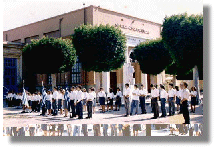 1857-1885 There followed the Presidents Dimitrios Rizos (1857-1862), Constantinos Charalambis (1862-1863), Sophocles Constantinidis (1863-1871) and Theodoros Rallis (1871-1885), each continuing the philanthropic work of the Community. One of the main legacies of this time was the establishment of a new hospital, St. Sofronios'. This was the hospital which energetically served the Greeks of Alexandria, where German R. Koch, with the help of Greek doctors Kartoulis and Valasopoulos, would isolate the cholera virus during the epidemic of 1883, which resulted in the development of a vaccine against the disease, and where Constantine Cavafy died in 1933.
1857-1885 There followed the Presidents Dimitrios Rizos (1857-1862), Constantinos Charalambis (1862-1863), Sophocles Constantinidis (1863-1871) and Theodoros Rallis (1871-1885), each continuing the philanthropic work of the Community. One of the main legacies of this time was the establishment of a new hospital, St. Sofronios'. This was the hospital which energetically served the Greeks of Alexandria, where German R. Koch, with the help of Greek doctors Kartoulis and Valasopoulos, would isolate the cholera virus during the epidemic of 1883, which resulted in the development of a vaccine against the disease, and where Constantine Cavafy died in 1933.
1885-1899 In 1885 Alexandrian GEORGE AVEROF took over the presidency. He and his fellow benefactors C. and G. Zervoudakis, C. Salvagos and Emm. Benakis, undertook great philanthropic works.
In 1878 the Community High School was founded. It was named after Averof in 1886 and still operates today as the Averof High Schools.
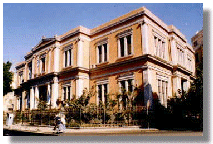 As the number of Greek children in the city continued to grow EKA, built the Averof Girls' School which opened in 1896. Over the next three generations thousands of Greek pupils passed through the doors of the school. After its closure in 1963, the buildings and playing fields were offered to the Greek State which established the first Hellenic Trade and Exhibition Centre there.
As the number of Greek children in the city continued to grow EKA, built the Averof Girls' School which opened in 1896. Over the next three generations thousands of Greek pupils passed through the doors of the school. After its closure in 1963, the buildings and playing fields were offered to the Greek State which established the first Hellenic Trade and Exhibition Centre there.
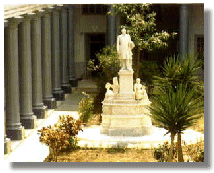 Averof, the great national benefactor is remembered for his contributions in Greece too. The building of the Metsovion Polytechnic in Athens had begun with funds from Alexandrians Tositsas and Stournaras and was completed by Averof. He was also responsible for the building of the School of Evelpidon, the juvenile prison in Athens and the Agricultural School in Larissa. He donated large sums of money and agricultural land to the Community of Metsovo and funded the Odeion Music School in Athens. He also donated one million drachmas for the restructuring of the Athens stadium. The battleship "G. Averof", which played an important role in the history of the Greek navy, was paid for largely with Averof's personal contribution.
Averof, the great national benefactor is remembered for his contributions in Greece too. The building of the Metsovion Polytechnic in Athens had begun with funds from Alexandrians Tositsas and Stournaras and was completed by Averof. He was also responsible for the building of the School of Evelpidon, the juvenile prison in Athens and the Agricultural School in Larissa. He donated large sums of money and agricultural land to the Community of Metsovo and funded the Odeion Music School in Athens. He also donated one million drachmas for the restructuring of the Athens stadium. The battleship "G. Averof", which played an important role in the history of the Greek navy, was paid for largely with Averof's personal contribution.
The beginning of the 20th century saw an increase in the population of Greeks in Alexandria which is said to have reached 150,000, and an improvement in the standards of living, which in many respects were superior to those in Greece itself.
